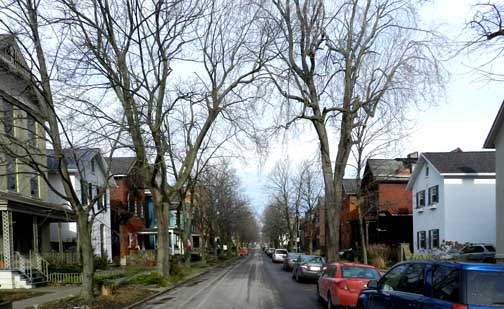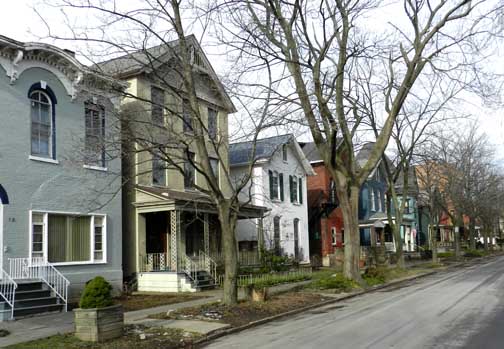![]()
North Pearl Street, Buffalo, NY
Located in the Allentown Historic District (National, State, Local)
#1 ..... #17 ..... #18 ..... #34 ..... #44 ..... #47 ..... #56 ..... #58 ..... #74 ..... #120 ..... 174-182 Text (below)
 Looking north between Virginia and Allen streets   East side |
Nationally, the post-Civil period was a booming time. Buffalo continued
to grow, but it did not prosper as much as Rochester, Syracuse and New
York City. For one thing, trains were shipping more grain than were the
canals Buffalo had come to depend on. Buffalo's advantage was
particularly weakened during the frozen winters, when ice blocked the
canals. Nevertheless, businesses were thriving, and many of the oldest
downtown houses were demolished, to make room for commercial
development. Again, Buffalo lost its earliest buildings.
New homes were built in Johnson Park and Allentown, for both workmen and wealthy families. Working families would later use some of these "workmen's cottages" to do piecemeal labor at home for neighborhood leather businesses. Elaborate Italianate-style mansions were built on Franklin Street in Allentown. At the same time, smaller Italianate-style homes were built on Arlington, College, Edward, Hudson and North Pearl Streets in Allentown. Most of these homes were built in the simple, front-gabled design.... North Pearl is a lovely shaded street with homes built for Buffalo's post-Civil War upwardly mobile population. With some exceptions in the 1950s, the street and homes have been conscientiously preserved. It is perhaps the best area in Buffalo for viewing a large number of intact moderate brick Italianates. Many of these homes have been used as rooming houses. - Sonia R. Efron, Buffalo's Brick Italianates: An Allentown Legacy, Self-published, 1994
|
|
North Pearl Street is, in many ways, the most conscientious example of
a prosperous Victorian residential street left in Buffalo, despite the
changes suffered by some of its homes during the 1950's infatuation
with modernization... North Pearl Street homes were built for 19th
century Buffalo's upwardly mobile population and the structures reflect
their builders post-Civil War prosperity. They are conservative mirrors
of period styles, but built in brick and stone rather than in wood.
Most importantly, these well-to-do young settlers could afford ornament
and nearly every house on the street wears elegant and often unusual
jewelry.
- Allentown Association (Jan. 2012)
|
